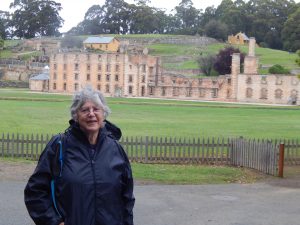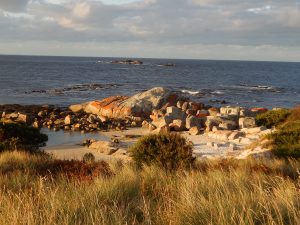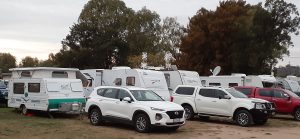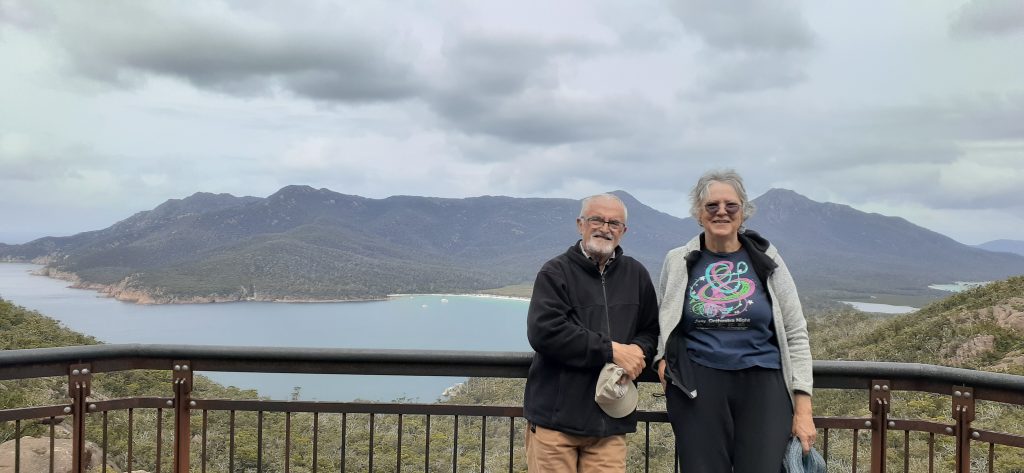
If you have a yen to go to Tasmania, here’s three key pieces of advice. Go in spring or autumn, take clothing and footwear for all seasons and, most importantly, allow more time than we had (18 days).
I’m taking up the travelogue as we arrived for three days in Hobart (having arranged to drop our car into the dealers to troubleshoot a faulty sensor). We checked in to the Hobart showgrounds, a spacious complex close to the city.
After luckily finding a good ‘local’ breakfast cafe in the city, we set off on a day tour of Hobart. The double-decker bus found its way into some tight spots (a lookout at Battery Point). Our driver informed us that Battery Point has the country’s most expensive real estate (per square metre). We spent an hour at the Royal Tasmanian Botanical Gardens, a compact but very beautiful oasis with a Japanese garden (and an ice cream van we didn’t manage to find). We went to the Cascades and heard all about an early settler, Peter Degraves, who had a plan to use the crystal clear water from the Cascade springs to build a brewery.

He formed this plan while doing time in Hobart gaol for fraud. On his release in the early 1830s he set about building the Cascade Brewery, which is still operating, producing beers and non-alcoholic beverages. It is not only a working brewery but a tourist attraction.
In the afternoon we headed off on a catamaran which took us to one of Hobart’s modern curiosities, MONA (Museum of new and old art). The catamaran ride was splendid, sailing at speed under the Tasman Bridge, catching sight of Australia’s $529 million icebreaker, Nuyina, which is based in Hobart. (Ed: The boat ride was nice – MONA was pretentious, IMHO)
Saturday was a day of highlights. First a day trip through the beautiful Huon Valley to Geeveston where friends introduced us to a gourmet café, The Old Bank, which serves local game dishes. Go there! In the late afternoon we set off to Rosny, which is a nearby suburb of Hobart where songwriter Fred Smith was performing that night. Fred recruited a local band to present his latest concert about Afghanistan, which includes the evacuation of 4000+ people with Australian visas from Kabul Airport. It’s a harrowing audio-visual presentation with images, videos and Fred’s narration, coupled with his insightful songs about Afghanistan and Afghans.

On Sunday we set off for Port Arthur. Like all road journeys in Tasmania, the distances are short but the roads require more careful, slower driving than we are used to on the mainland. I’d not been to Port Arthur before, but the ruins of the convict colony are evocative and the guides are knowledgeable. This is one place where you could spend an extra day, as the ticket to the historic site is also good for the following day. There’s such a lot to take in.
On balance, our colonial forebears treated convicts as brutally as they slaughtered the indigenous people of Tasmania. The cat of nine tails, which was traditionally steeped in sea water so crusts would form on the knots, was a particularly barbarous instrument of punishment. It was not uncommon for convicts to receive 100 lashes. Some of them died as a result. It’s not hard to conjure up the atmosphere when this place was home to 2,000 people, including 1,200 criminals we’d call recidivists (re-offenders) today.
From Port Arthur we drove up the fabled East Coast with its scenic wonders and wildlife. On advice from a friend we stopped at Eaglehawk Neck, a narrow isthmus containing another convict relic. An officer’s garrison was built at Eaglehawk Neck to capture convicts trying to escape Port Arthur. The Dogline at the narrowest part of the neck is where a line of ferocious dogs patrolled to prevent convicts escaping. We also took in a couple of spectacular blow-holes which are common on the Tasman coast.

We were aiming for Swansea but accidentaily ended up at a lovely free camp at Mayfield Beach. The Mayfield Beach Conservation Area was quite popular but we managed to manoeuvre our van into a site under some trees. It was right next to the road but after 7pm there was so little traffic it was not an issue. The park is maintained by park rangers but is in fact a scenic reserve. There are loads of places like this around Tassie and the best part is that, unlike a lot of Queensland free camps, you can stay for 2, 3 or even 4 weeks. (The Mayfield Beach camp sign says in small letters that merely moving to a different site after 30 days is not permitted).
Next day we did tourist stops at Kate’s Berry Farm, a popular place for people who appreciate good coffee and blackberry jam. Then we went to a strange place called Spiky Bridge. It is part of the infrastructure built by convicts with the aim of thwarting overland escape from Port Arthur.
Later we took the steep walk to the lookout at Wineglass Bay, admiring the young couple who took a two-year-old girl and a baby in a backpack to the top and back again. Those kids will grow up loving the wilderness and never know why. The mother took our photo up there, while we were trying hard to look as if we had got our breath back, given the so-so cardio fitness of a pair of 73-year-olds. Friends who have done this walk in the past tell us it used to be a rock scramble to the top. No fancy lookout and safety barriers then.

We stopped the night at Bicheno at a caravan park because the Coles Bay national park camp site was full. The bonus was we could spend a good few hours at Natureworld, with its well-stocked aviaries, local fauna and a disease-free colony of Tasmanian Devils. We got there in time to watch these ugly critters fighting over a kangaroo tail. Been there, got the T-shirt. (Ed: they were a bit cute – like a Staffie!).
We ended up staying in a caravan park again at St Helen’s when, if we’d thought about it, we could have travelled into the Bay of Fires and stayed at one of the many free camps on the beach. Ah well. We had a jolly fine day trip including a walk along the beach from Walsh’s Lagoon. You can walk the whole 11km from Binalong Point to Eddistone Point along the the Bay of Fires. The walk is mainly along the beach but the trek implies a bit of organisation in a group with a car at either end. Bay of Fires is distinguished from other beaches by its orange granite rocks (the colour is caused by lichen. There are also ancient middens along this trail, evidence of indigenous settlement. We reached the northerly terminating road (The Gardens) near sunset which is the right time to be there although there was a bite to the wind.

We got chatting to a guy with a vintage Chev truck built on a Holden chassis with a V8 engine. He was on his way to a hot rod rally at Ulverstone near Devonport. The things people spend money on, eh!
Next day we set off on a hilly winding road to Scottsdale, stopping along the way at the Pyengana Cheese factory (recommended) where we had freshly made scones with home-made butter and cream. We bought our rellies some cheese to go with their Huon pine cheese board.
From there we drove on to one of Tasmania’s famous short walks – St Columba Falls. It is a short, east walk apart from a bit of downhill to the lookout. Because Tassie’s been in a drought the tallest falls in the State were not roaring like they usually do. but spectacular none the less.
The 15 minute walk goes through myrtle and sassafras groves with an under story of ferns, moss and fungi. Later on the drive we stopped at Weldsborough to check out an ancient myrtle grove with the ubiquitous understory of moss, fungi and ferns, Very dark and prehistoric.

Not everything in Tasmania looks like that. Earlier in the day I tried (and failed) to take a ‘Tasmanian Mullet’ photo – where the lower slopes of a steep hill had been clear felled for pasture, leaving forest remnants clinging to the top, like a monk’s tonsure.
The hilly drive to Scottsdale, east of Launceston, goes through the town of Derby which has become famous among mountain bike enthusiasts. There are several bike shops there which hire bikes and take riders in tour buses to the many organised trails through the hills.
We stayed at a free camp in Scottsdale, Northeast Park, which is named after George Northeast who first established a community pool and reserve there in the 1930s. The project was taken up again in the 1980s by the local Lions group who did a lot of work establishing picnic facilities and tracks for walkers and cyclists.
On our way to Devonport we stopped in at Sheffield, known as the town of murals, to catch up with friends. Saturday morning we queued to board the Spirit of Tasmania for a day voyage. The thoughtful people at Devonport provide a toilet for people sitting in their cars waiting to board. Four stars! And five stars to Bass Strait which turned on one of its swell-less days for a smooth voyage. We arrived in Melbourne at 8.30pm and then navigated our way through the suburbs to a caravan park in Coburg. (Ed: night driving on a Melbourne freeway not recommended when towing a van). t was the weekend of the Grand Prix so the van park was full and it took a while to sort out where we were supposed to park. But by 9.30 were set up – exhausted and ready for bed.
The journey home was Melbourne to Albury, then to Cowra which has a Japanese prisoner of war cemetery and a Japanese garden. On to Dunedoo where we ran into friends who were on their way to the National Folk Festival. Somewhere along the road I got a call from well-known folk singer Bob Fagan to say that my song, ‘When Whitlam took his turn at the wheel’, was this year’s recipient of the Alistair Hulett Songs for Social Justice award. It was presented at the National Folk Festival’s closing concert (in my absence). My songwriter friend Ross Clark who accepted the award on my behalf, has since been sending me photos of the award (like a garden gnome) posed in various locations as he travelled back to Brisbane.

I’ll leave you with this image, from Cowra Showgrounds, with a flotilla of road rigs (ours on the left) lined up ready for a 5am getaway. These are just a few of the 800,000 registered recreational vehicles on Australian roads. As the ABC reported this week, those on the road include families seeking lifestyle changes and ditching the school system after lengthy pandemic lockdowns and restrictions. Many are on the road permanently, both for reasons of lifestyle and necessity (more on that next week).
So that’s our land and sea return journey to Tasmania, some 6,500 kilometres in 30 days. Now you know why we needed to shout ourselves a night at Armidale’s Moore Park Inn and dinner at Archie’s restaurant on the last night. Hang the expense.
(all photos by Bob & Laurel Wilson)
PS: Last Saturday I got a call from an 03 number. I ignored it, as you do, but the number left a voice mail. It was a friendly young woman from TT-Line Company, better known as the Spirit of Tasmania. Had I lost anything on my recent holiday, Sally asked? ‘Ah, yeh, I still haven’t found my teblet’, I said, realising that when I’m anxious I revert to Kiwi. After a few key questions (make, size, colour), Sally asked for my pass code. It must be a different one to the one I use at home because it wouldn’t open. Not to be thwarted, Sally asked me if I had another email address (I do). I deduced she’d spotted my Gmail address when she tried to turn it on. I’m expecting it back any day now.


 Sometimes we come across quite an impressive ‘free camp’ – the one at Wyalong being an example. There was plenty of room as well as some interesting displays such as a reproduction miners’ hut. We stopped there for a lunch break on our way to Narrandera. This area is in the ‘Bland’ shire (named after an early European settler, rather than a description of the surroundings). Someone there has a sense of humour, as they have combined with the town of ‘Dull’ (a village in Scotland) and ‘Boring’, which is in Oregon, to form the ‘League of Extraordinary Communities’) Their slogan was ‘Bland- far from Dull and Boring’.
Sometimes we come across quite an impressive ‘free camp’ – the one at Wyalong being an example. There was plenty of room as well as some interesting displays such as a reproduction miners’ hut. We stopped there for a lunch break on our way to Narrandera. This area is in the ‘Bland’ shire (named after an early European settler, rather than a description of the surroundings). Someone there has a sense of humour, as they have combined with the town of ‘Dull’ (a village in Scotland) and ‘Boring’, which is in Oregon, to form the ‘League of Extraordinary Communities’) Their slogan was ‘Bland- far from Dull and Boring’. Our Ferry ride to Tasmania wasn’t until the next evening, so we had a whole day in Melbourne to do some sight-seeing. We were rather thrilled to have a celebrity tour guide. Margret RoadKnight took us first to the Van Gogh installation. This had been to Brisbane, but we didn’t see it there, so it was a treat to experience it in Melbourne. Several of his paintings were projected video style along the walls of the exhibition space, interspersed with information about his life. Van Gogh sold very few of his works during his lifetime, but he said he was sure that one day his paintings would be worth more than the cost of the canvas and the paints he put on them. Very prophetic of him.
Our Ferry ride to Tasmania wasn’t until the next evening, so we had a whole day in Melbourne to do some sight-seeing. We were rather thrilled to have a celebrity tour guide. Margret RoadKnight took us first to the Van Gogh installation. This had been to Brisbane, but we didn’t see it there, so it was a treat to experience it in Melbourne. Several of his paintings were projected video style along the walls of the exhibition space, interspersed with information about his life. Van Gogh sold very few of his works during his lifetime, but he said he was sure that one day his paintings would be worth more than the cost of the canvas and the paints he put on them. Very prophetic of him. Next morning saw us in Devonport. We took a slow drive to Stanley, stopping at Ulverstone for breakfast and at the little town of Penguin, where Bob posed for the obvious photo alongside the giant penguin statue. Stanley’s main feature is ‘The Nut’, a large flat-topped rock – remnant of some ancient volcanic activity. There is a walking track to the top, but we were satisfied with walking half-way up the very steep track, stopping several times for photographs (or to catch our breath – probably the latter). There is a chair lift to the top too, but it was not operating on the day because of the strong wind gusts. I suspect I may not have partaken of it at any rate.
Next morning saw us in Devonport. We took a slow drive to Stanley, stopping at Ulverstone for breakfast and at the little town of Penguin, where Bob posed for the obvious photo alongside the giant penguin statue. Stanley’s main feature is ‘The Nut’, a large flat-topped rock – remnant of some ancient volcanic activity. There is a walking track to the top, but we were satisfied with walking half-way up the very steep track, stopping several times for photographs (or to catch our breath – probably the latter). There is a chair lift to the top too, but it was not operating on the day because of the strong wind gusts. I suspect I may not have partaken of it at any rate. We were in Tasmania to do some walks, so walk we did – around the circumference of Dove Lake. This is classified as a grade 3 walk, so quite do-able for the average person, but I wouldn’t say it was a walk in the park (Ed: bahaha). Actually we were pretty fatigued by the time we got to the end and hopped or staggered back on to the bus to take us back to the campsite. Groans on getting aboard the bus were fairly common, so I didn’t feel too conspicuous.
We were in Tasmania to do some walks, so walk we did – around the circumference of Dove Lake. This is classified as a grade 3 walk, so quite do-able for the average person, but I wouldn’t say it was a walk in the park (Ed: bahaha). Actually we were pretty fatigued by the time we got to the end and hopped or staggered back on to the bus to take us back to the campsite. Groans on getting aboard the bus were fairly common, so I didn’t feel too conspicuous. From there, it was on quite a scenic route to Strahan, a fishing port on the West Coast of Tasmania. It is also a major tourist attraction, as it is from there that tourists can catch the boat trip up the Gordon River. It was another beautiful late summer/early autumn day with barely any wind and a very smooth sail on the large passenger boat. Definitely a ‘must do’ if you’re touring Tasmania. The cruise included a passage through the narrow ‘Hell’s Gates’ – named either for the difficulty of the passage in a sailboat and/or the feelings of the convicts transported to the notorious Sarah Island penal settlement. On the way to Sarah Island, we passed several Salmon and Trout ‘farms’ anchored in the harbour. The ecological wisdom of these has been disputed, particularly by famous author Richard Flanagan whose title for his work about the salmon farms is ‘Toxic’. Sarah island has some very good interpretive signs indicating the original buildings that are now in quite deteriorated condition. The cruise included a stroll through remnant rainforest – trees of such ancient lineage that their ancestors grew before birds were part of earth’s ecology. A silent forest.
From there, it was on quite a scenic route to Strahan, a fishing port on the West Coast of Tasmania. It is also a major tourist attraction, as it is from there that tourists can catch the boat trip up the Gordon River. It was another beautiful late summer/early autumn day with barely any wind and a very smooth sail on the large passenger boat. Definitely a ‘must do’ if you’re touring Tasmania. The cruise included a passage through the narrow ‘Hell’s Gates’ – named either for the difficulty of the passage in a sailboat and/or the feelings of the convicts transported to the notorious Sarah Island penal settlement. On the way to Sarah Island, we passed several Salmon and Trout ‘farms’ anchored in the harbour. The ecological wisdom of these has been disputed, particularly by famous author Richard Flanagan whose title for his work about the salmon farms is ‘Toxic’. Sarah island has some very good interpretive signs indicating the original buildings that are now in quite deteriorated condition. The cruise included a stroll through remnant rainforest – trees of such ancient lineage that their ancestors grew before birds were part of earth’s ecology. A silent forest. The two hour walk at Lake St Clair was well worthwhile and not quite as challenging as the Dove Lake walk. Fewer tourists too, which made bird-watching more feasible. Birdlife was plentiful, but not co-operative with the amateur photographer, so no photographic proof. I did get a photo of the Tiger Snake which was lying curled up near the walking track. Tassie’s Tiger Snakes are black with pinkish bellies, similar to the mainland Red-Bellied Black Snakes, but the former are reputedly much more aggressive and toxic, so we were glad this one appeared to be pretty sleepy!
The two hour walk at Lake St Clair was well worthwhile and not quite as challenging as the Dove Lake walk. Fewer tourists too, which made bird-watching more feasible. Birdlife was plentiful, but not co-operative with the amateur photographer, so no photographic proof. I did get a photo of the Tiger Snake which was lying curled up near the walking track. Tassie’s Tiger Snakes are black with pinkish bellies, similar to the mainland Red-Bellied Black Snakes, but the former are reputedly much more aggressive and toxic, so we were glad this one appeared to be pretty sleepy!